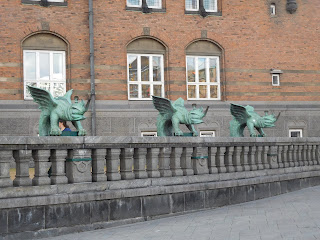Monday, September 23, 2019
Tuesday, September 17, 2019
Copenhagen Three
So then, we took the bus to the centre and visited the Ny Carlsberg Glyptoteket. That's Carlsberg as in the beer and this is a truly impressive collection of sculpture and works of art, originally the private collection of one man. There's a lot of money to be made in brewing.
Downstairs a collection of sculpture, including several Rodins.
And a full-scale winter garden.
Upstairs, a comprehensive selection of French Impressionist paintings.
And from the roof terrace, spectacular views over the city.
This is as close as we came to the thrills of the Tivoli Gardens.
We ended the morning with lunch at the Canal Restaurant, true to its name as we were on a barge moored on the canal. Groups of Danes were settling in to lunch on pickled herring on rye bread, washed down by aquavit and draughts of beer.
Monday, September 16, 2019
Copenhagen two
We took the train across town to the Danish National Gallery, which was featuring an exhibition of the Danish golden age of painting. This was a surprising phenomenon as it seemed to coincide with a low point in Danish history after Copenhagen had been bombed by the British during the Napoleonic Wars, and the state had declared itself bankrupt. As I said, we learnt a lot about Danish history on this trip.
Moving on to the Rosenborg Slot (Castle) we could hear a military band playing in the street. On they came, right across the park as it appears that there is a military establishment right there.
The castle itself is built on fairy tale lines and dates from the 1600s. Dark interiors, and wood panelling, with what we would call Jacobean fireplaces. On the top floor, a long gallery set up as the Throne room. Note the lions guarding the thrones.
A display of glass, backlit by the window.
And in the basement, the Crown Jewels.
At the entrance we did see two very bored-looking armed soldiers.
Then it was on to the Round Tower, once an observatory.
Inside instead of a spiral staircase, there is a spiral ramp, wide enough to drive a horse and carriage up it.
From the top extensive views over the city. We were struck by the complete absence of towering modern structures, as in London. Just traditional city blocks punctuated by traditional spires. This undoubtedly adds to the human scale of the whole place.
Sunday, September 15, 2019
Copenhagen
To Copenhagen, for a few days of sightseeing and culture. We certainly know a lot more about Danish history than ever before.
We began in the National Museum, where we were intrigued by the collections of objects recovered from the bog, or Moss. It was the custom to place objects in the bog as sacrifices, and there is some evidence of human sacrifice too. Conquered tribes would have all their weapons given to the bog. In this case, a large ceremonial vehicle was dismantled and buried in the bog.
From there we went on to the Slotholmen or Castle island, taking in lunch at the Black Diamond Library café on the way. We toured the Christiansborg castle, where the Danish Parliament sits and the Prime Minister has his office. We were struck by the lack of security at any point around the building, unlike, for example, the British Museum.
This is the third version of the castle as it burned to the ground twice and was rebuilt in the early 1900s.
Chandeliers and damask everywhere but also some unusual imagery of wild birds.
On the way to the Castle Island we passed the Stock Exchange building, dating from the early 1600s. Who could account for the fantastic spire on the top of this building?
We went down under the palace to look at the castle ruins, a very strange experience. At the time of the last rebuild they excavated the remains of the earliest fortress and, instead of filling them in, they used reinforced concrete arches and built the palace and its huge tower on the top. So we were able to see the original walls, well, baking ovens and drainage system.
After all this, our feet were telling us to call it a day.
Subscribe to:
Comments (Atom)
































.JPG)